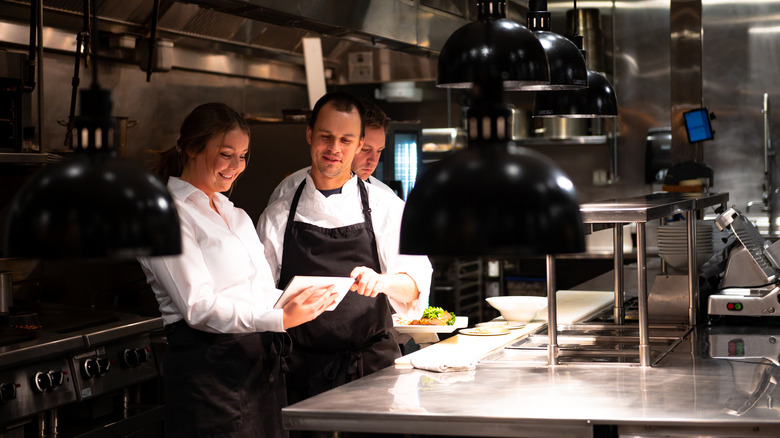How Restaurant Employment Has Shifted Since The Pandemic
After the national labor shortage devastated the food service and hospitality sector, slowly but surely, workers have been returning in recent months to fill the vacant positions. But, even now, restaurants and bars are operating with roughly 87,000 fewer employees than they had in February 2020, pre-pandemic. A shift in the tides may be well underway, however. According to a May 2 report by the Bureau of Labor Statistics, the quit rate in the food service industry has been gradually slowing, indicating that folks may finally be settling into their positions — and the positions themselves are looking a little different post-pandemic, too. Per a recent report by industry trend analytics platform Chef's Pencil, it looks like restaurants are hiring more cooks than servers on an industry-wide scale.
From 2019 to 2022, restaurants hired 100,000 cooks, yet server employment dropped by 1.2 million. Still, of that relatively small employee pool, folks are going home with substantially larger paychecks. Server and bartender wages, on average, have seen a 23% increase since 2019. In 2022, chefs and head cooks took home an average annual salary of $60,210, the first time in U.S. history that average chef pay has crossed the $60k mark. Restaurant cooks earned $33,940.
Focusing on production over service
This new focus on production makes sense considering the sustained and growing popularity of ordering takeout since the pandemic. Third-party delivery services have taken on lives of their own, with Grubhub raking in a whopping $2.4 billion in revenue in 2022 alone, a 5% increase from 2021. DoorDash saw even higher figures with a 34% increase from 2021 to 2022 for a total yearly revenue of $6.58 billion.
Hiring more cooks than servers could also indicate a larger industry shift toward a new style of service: Making way for artificial intelligence technology. McDonald's and Taco Bell have already been testing AI drive-thru ordering systems to reduce human workload, allowing employees to assemble orders more efficiently and dodge abuse from customers. These fledgling developments could mark the beginning of a new age of food service as workers move from serving to cooking en masse.
For now, the broader implications of this newly published data extend beyond whether restaurants are focusing on service or production. Are workers picking up more hours, or wearing too many hats? Unfortunately, hospitality has accrued a pretty unsavory reputation as a hotbed for worker exploitation, and it can be hard to tell whether these new data trends are a good thing or a bad thing.
The future of restaurant work in the post-pandemic world
A 23% wage increase for cooks from 2019-2022 is an impressive figure, but there are also a number of confounding variables at play to consider, not the least of which is the inflation crisis of the last two years in particular. Plus, food service workers remained on the front lines of the COVID-19 pandemic (which was encompassed in the study's timeline) and infamously did so without any hazard pay in many cases.
Per Chef's Pencil, the number of cooks and chefs employed in the U.S. is currently at a record high. Yet, even with all these new jobs, employment in the food service industry is still down by 7% from pre-pandemic levels. The labor shortage is far from over, or confined to the hospitality sector alone. According to a recent U.S. Chamber of Commerce report, 1.97 million fewer Americans are working compared to 2019. As of May 16, 2023, there are 9.9 million job openings and only 5.8 million estimated unemployed persons to fill them. The wage increase for cooks and bartenders realistically might not boast all the glamor that it seems, but regardless, it's still a good sign for the industry and the workers who run it.


